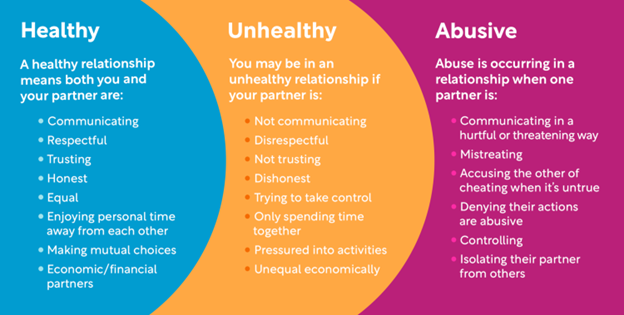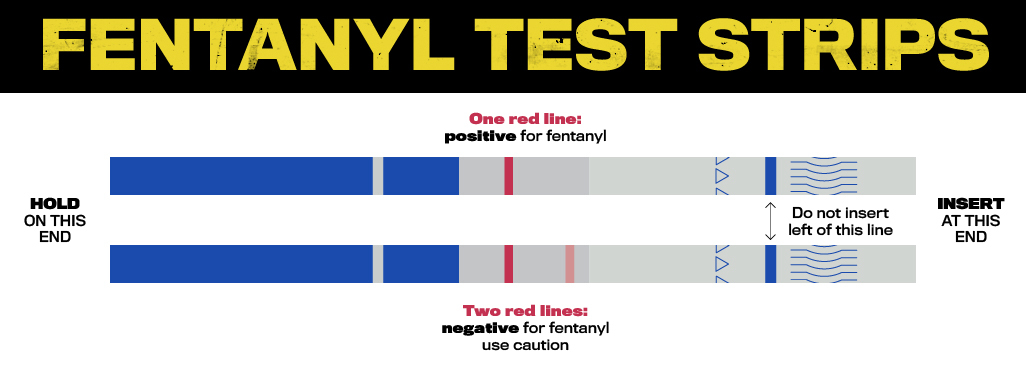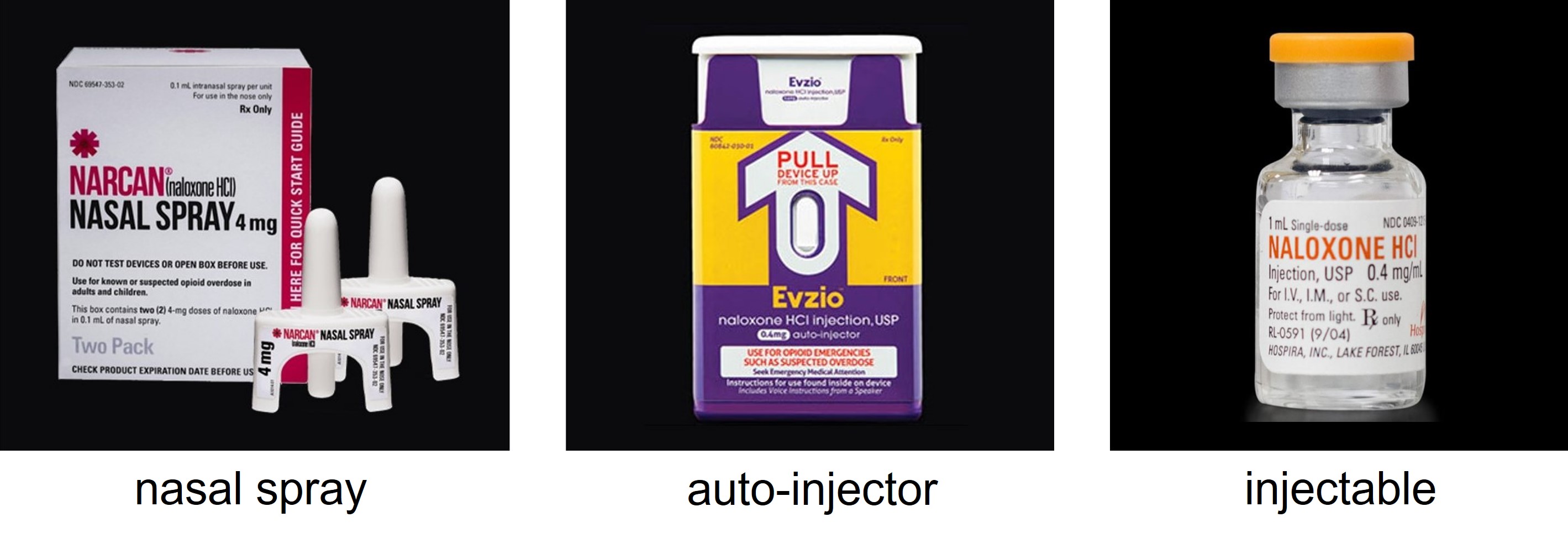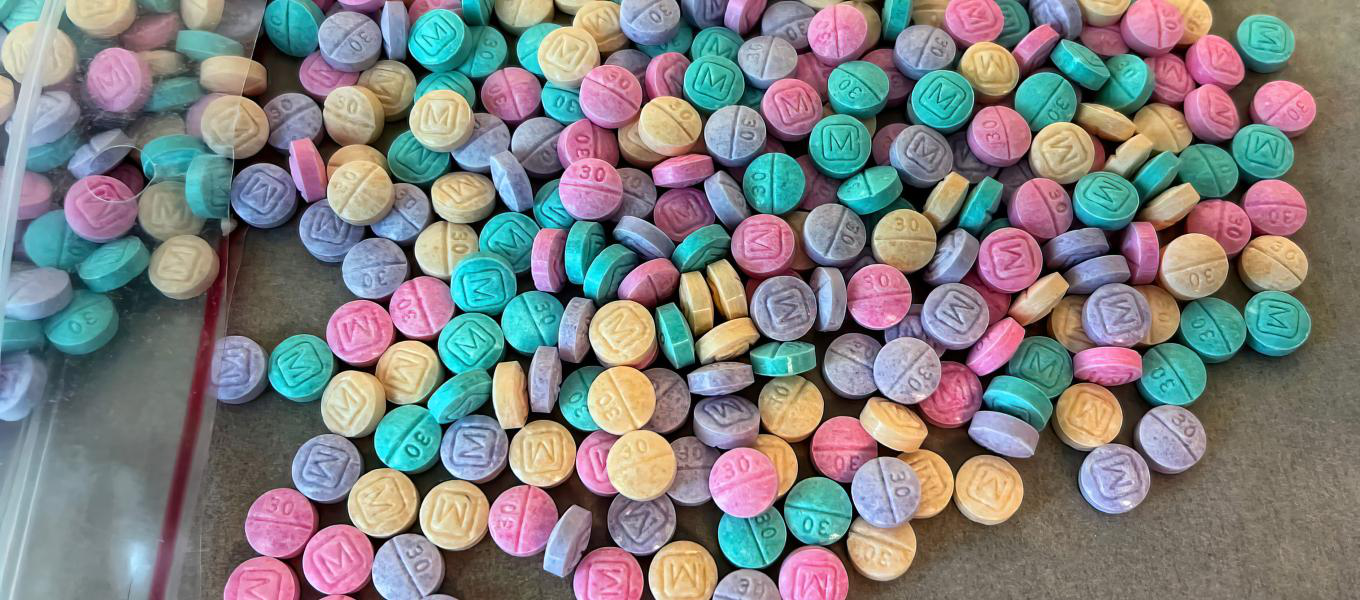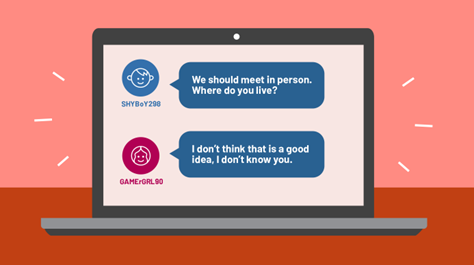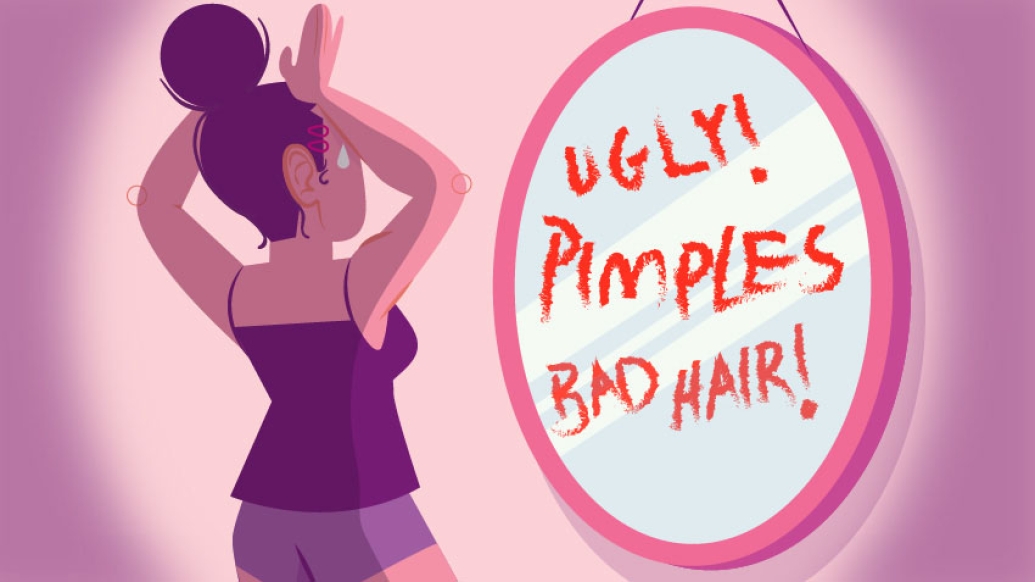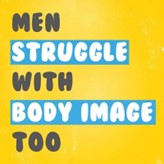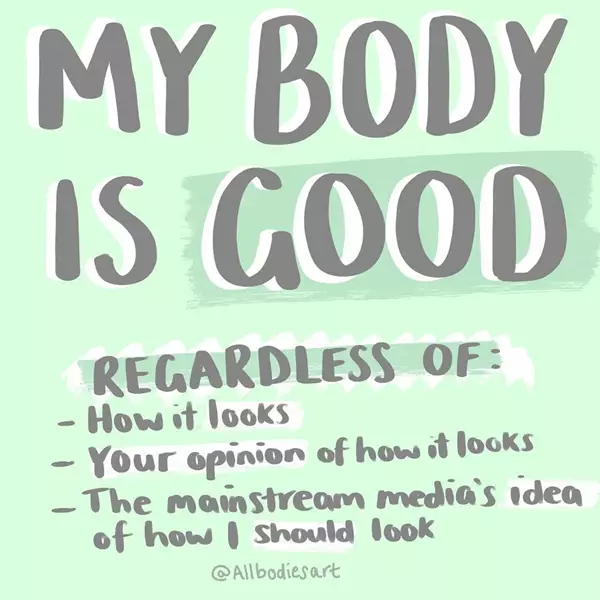If you or someone you know is experiencing a mental health crisis and needs immediate assistance, please call "911" or "988" and explain the nature of your problem. 911 will bring you to a police operator and 988 will bring you to a counselor trained in mental health crisis response.

Addressing Teen Mental Health Challenges
Toolkit Tailored for You
Health Insurance
In California, foster youth under age 18 are automatically enrolled in Medi-Cal and this coverage continues until you turn 26 years old.
Some considerations:
- If you are on your parent’s insurance plan, after receiving services, your parent will receive a report called an Explanation of Benefits (EOB). Although the report will have your name on it, it will arrive to your parent’s listed address. This could be a concern if you want to keep your services private.
- Accessing free and low cost-services (clinics or hotlines) are an alternative.
Suicide: Thoughts, Behaviors and Attempts
Having thoughts of, or attempting, to commit suicide now? Don’t go through this alone, counselors are available!
-
Call, text, or chat with the 988 Suicide and Crisis Lifeline – What can I expect if I contact them?
- Available 24 hours a day, 7 days a week.
- They provide free and confidential emotional support to people in suicidal crisis or emotional distress.
- Talk to someone now. Ask your parent, another trusted adult, or a friend for help.
- Connect with peers, mentors, and other loved ones
- Try to have frequent, consistent conversations with friends and loved ones about managing emotions, healthy coping skills, and conflict resolution
- Practice spiritual and cultural traditions and rituals
- Find trusted and competent mental health care providers that reflect your family’s culture, beliefs, and/or values
- Remove access to lethal methods of hurting oneself or others (firearms, stockpiled medications, other weapons).
- Speak up and look for safe spaces if you identify as LGBTQIA+ youth, disabled youth, youth of color, or are pat of another underrepresented groups. These safe spaces might be at school and other shared community locations.
- View Stories of Hope and Recovery
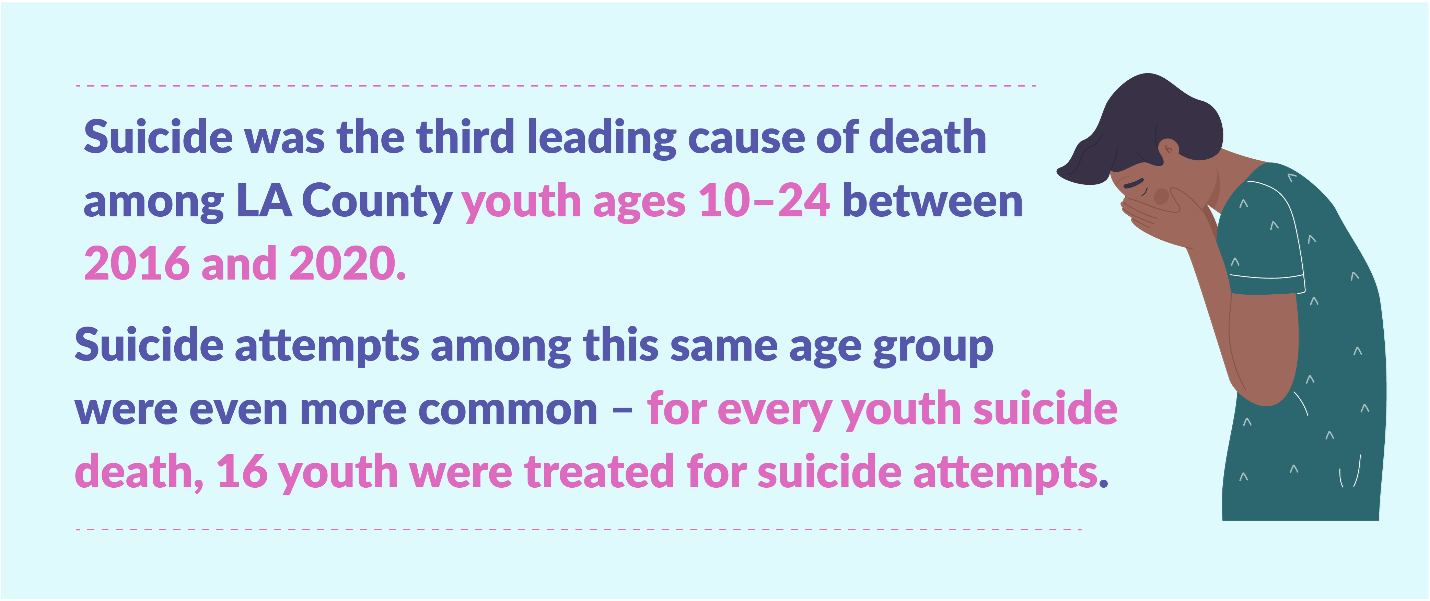
California Department of Public Health. (n.d.). 2016-2019 Mortality Data from CDPH Vital Statistics, Provided by Los Angeles County Department of Public Health Office of Health Assessment and Epidemiology. https://wonder.cdc.gov/ucd-icd10.html
Centers for Disease Control and Prevention. (n.d.). 2020 Provisional Mortality Data from California Department of Public Health Vital Statistics. https://www.cdph.ca.gov/Programs/CHSI/Pages/Data-and-Statistics-.aspx
- Talking about suicide or hurting oneself (using both specific language and context clues)
- Talking about it (using both specific language and context clues)
- Looking for ways to end your life (planning or seeking access to lethal means)
- Giving away prized possessions
- Visiting, texting, or calling people to say “goodbye”
- Signs and symptoms of depression and anxiety
Stress, Anxiety and Depression
Experiencing stress, anxiety or depression now? Don’t go through this alone, support is available!
-
Seek professional support if:
- Stress/anxiety begins to take over your life
- Stress/anxiety limits your activities
- Anxiety has been persistent for over 6 months
- Depression has been present for over 2 weeks
- A healthy body supports a healthy mind: Eat nutritious meals, get quality sleep, and exercise regularly.
- News and social media breaks: News and social media can trigger stress and anxiety, take regular breaks from screen time.
- Unwind: This is important, especially after a stressful day. Try deep breathing, mindfulness techniques, guided meditation, stretching, yoga, and other techniques. Get started with meditation here.
- Make time for the things that bring you joy: Go for a bike ride, bake a cake, choreograph a dance, or hang out with your friend.
- Connect with others: Family and friends are usually great support systems. You may also want to get involved in school or community groups that support your interests.
- Create a stress catcher or a Personal Stress Plan
What is stress?
What are signs of stress?
- Feeling anger, sadness, worry, numbness
- Changes in interests, appetite, desires, energy
- Nightmares or trouble sleeping
- Trouble concentrating or making decisions
- Physical signs: body pains, skin rashes, nauseous, headaches
What is anxiety?
What are signs of anxiety?
- Excessive fear and worry
- Inner restlessness
- Excessively cautious and vigilant
- Continuous nervousness
- Physical signs: muscle tension, cramps, headaches, stomach aches, fatigue
What is depression?
Types of depression:10National Institute of Mental Health. (2023, April). Depression. https://www.nimh.nih.gov/health/topics/depression
- Major depression
- Persistent depressive disorder
- Perinatal depression
- Seasonal affective disorder
- Depression with symptoms of psychosis
What are signs of depression?
- Feelings of sadness, emptiness, loneliness, hopelessness
- Little to no interest in activities
- Changes in appetite, sleep patterns, weight, hygiene
- Thoughts about death or suicide
Unhealthy Relationships
Experiencing an abusive or unhealthy relationship? Don’t go through this alone, support is available!
- Prioritize your health and safety – contact police if you think you are in immediate danger. Visit a licensed medical provider for treatment if you have experienced physical and/or sexual abuse.
- Do not blame yourself. This is not your fault.
- Seek help from your support system. Talk to your parents or other significant adults in your life. Friends often are a great source of support.
- Decide next steps with your parent. Learn about personal safety and create your own safety plan, using the interactive guide to safety planning.
-
Consider involving a school counselor to integrate Title IX services provided by your school. They can help to create a safety plan with you which may include suggestions like:
- Buddy-walking between classes
- Using a code word between friends to indicate when help is needed
- Learn about local resources available to you and access online resources for additional support.
- Am I in a healthy relationship? Take the quiz now
Your teen years are where you learn to form safe and healthy relationships with friends, parents, caregivers, mentors, and romantic partners. These relationships allow you to explore different identities and roles and contribute to the development of your identity. Meaningful relationships are meant to add value to your life. Relationships that are, or become, stressful, rather than helpful and uplifting, negatively affect your mental health and wellbeing.
If these relationships are unhealthy, they can negatively affect your mental health and life. Unhealthy relationships are more common than you think. You wouldn’t know it because people may be afraid to tell anyone out feelings of embarrassment, shame, or trauma.
Here are some interesting statistics on teen dating violence:11Common, T. (2006). Dating Abuse Statistics.. Love Is Respect. https://www.loveisrespect.org/pdf/Dating_Abuse_Statistics.pdf
- 1 in 10 high school students has been purposely hit, slapped, or physically hurt by a boyfriend or girlfriend.
- 52% of teens who experience digital abuse are also physically abused.
- Only 33% of teens who were in an abusive relationship ever told anyone about the abuse.
- Only 9% of abused teens seek help, and rarely from a parent or teacher.
What makes a relationship healthy?
In a healthy relationship, you should feel safe and comfortable. Respect for yourself and others is a foundational component of a healthy relationship.
- Mutual respect – Each person values the other and understands their boundaries.
- Honesty – Each person is truthful and trusts the other.
- Compromise – Each acknowledges different points of view and is willing give and take.
- Individuality – No one must compromise who they are; their identity is not solely based on their partner’s likes and interests - they continue to see their friends and do the things they love.
- Healthy sexual relationship (if applicable) – Partners feel comfortable, they consent, they don’t feel pressured or forced to engage in a sexual relationship or activities that are outside of their boundaries.
What makes a relationship unhealthy?
One of the biggest signs of an unhealthy relationship is a power imbalance. A power imbalance often stems from at least one of the people in the relationship having trouble communicating and controlling their anger. It can lead to physical, emotional, or sexual abuse/violence.
- Control – One person makes all the decisions (what to wear, what friends to see, who to spent time with, etc.); they are unreasonably jealous and/or try to isolate the partner from friends and family.
- Intimidation – One person tries to control the other by making the other feel fearful or timid and may try to keep the partner from their friends and family, threaten violence or a break-up.
- Dependence – One person feels that they “cannot live without” the other. They threaten to do something drastic if the relationship ends.
- Violence – This can be physical, verbal, emotional, psychological, or sexual.
- Unhealthy sexual relationship (if applicable) - Pressuring sexual acts, lack of consent, controlling contraceptive usage (not allowing or demanding it).
What are common types of abuse?
- Physical
- Emotional and verbal
- Sexual
- Financial
- Digital
- Stalking
What are the warning signs of abuse?
Often at the beginning of a relationship, abusive people seem to lack flaws. As time passes, the abusive person tries to gain power and control over the other person. Abusive tendencies become more intense as the relationship develops over time.
- Extreme jealousy of friends or time spent away from them
- Preventing or discouraging time with friends, family, or peers
- Insulting, demeaning, or shaming, especially in front of others
- Preventing you from making your own decisions, even about work or school
- Pressuring sexual acts, controlling contraceptive usage (not allowing or demanding it)
- Intimidating
- Making threats
- Destroying your belongings
Trauma, Gun Violence and School Shootings
Experiencing trauma? Don’t go through this alone, support is available!
-
Seek professional support if:
- It begins to take over your life.
- It limits your activities.
- Validate the experience
- Take a social media and news break: Revisiting the event can contribute to trauma.
- Avoid making major life decisions.
- Maintain physical health: Eat nutritious meals, get quality sleep, get regular physical activity.
- Unwind: Try deeps breaths, stretches, mindfulness practices, journal.
- Do activities you enjoy.
- Connect with others: Family, friends, and other support systems.
-
Try these calming techniques:
- 4-7-8 breathing
- Five-finger breathing
- 5-4-3-2-1 grounding technique
- And more!
- Review Tips for Talking With a Mental Health Care Provider About Your Mental Health.
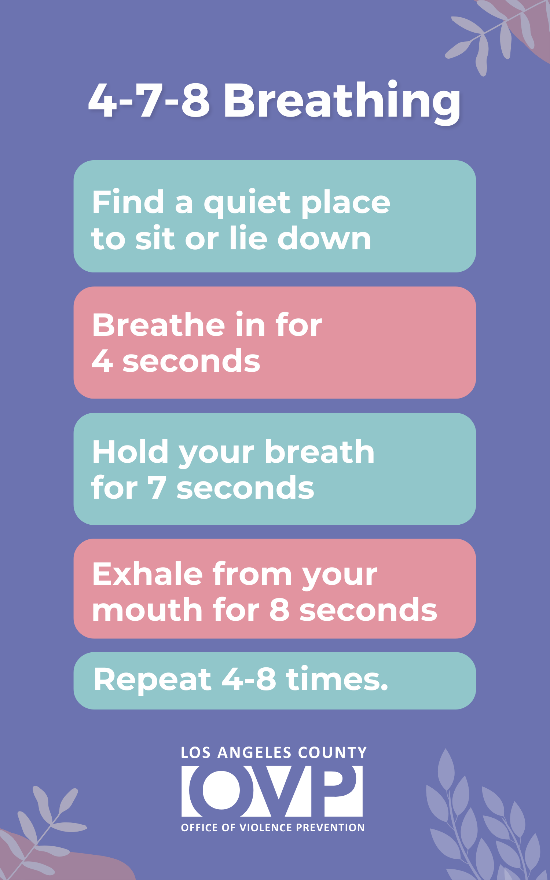
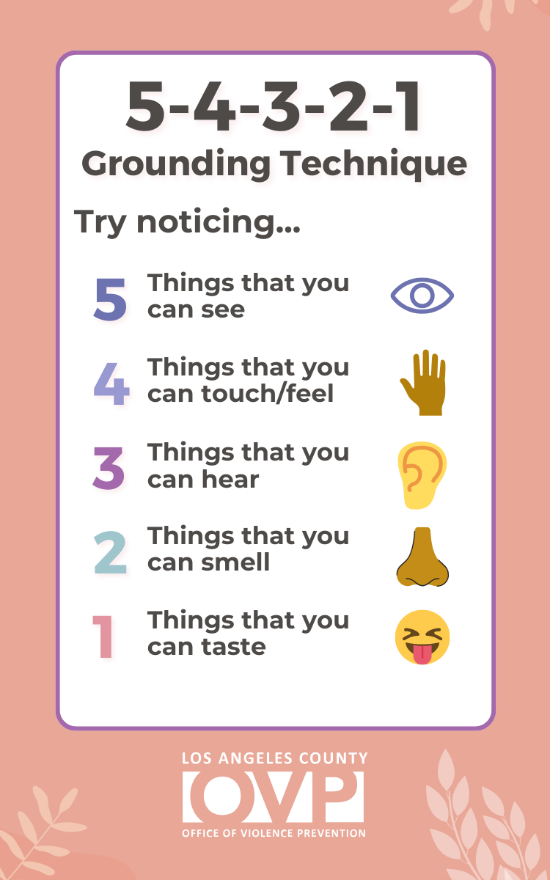
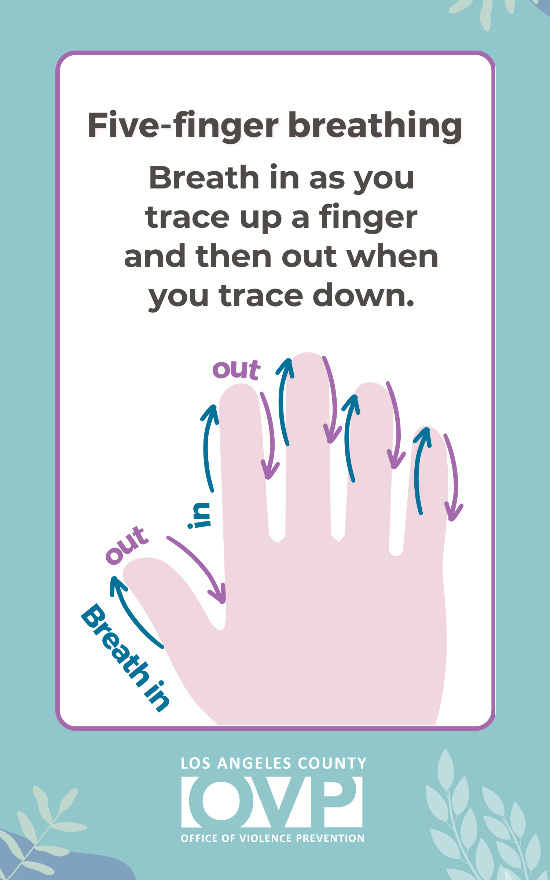
What is Trauma?
What Causes Trauma?
- Difficult life experiences such as neglect, loss, violence
- Victimization such as that associated with sexual abuse, physical abuse, emotional abuse, intimate partner violence, rape, and/or human trafficking
- Witnessing violent events such as terrorism or natural disasters
What Can Trigger Trauma?
Why School Shootings Are Traumatic
Signs of Trauma
-
Behavioral
- Clinginess
- Hyperactivity
- Emotional and psychological regression
- Difficulty socializing
-
Cognitive
- Difficulty concentrating
- Feeling confused
- Recurring nightmares
- Hopelessness
-
Physical
- Easily startled
- Physical weakness
- Changes in sleep, appetite
- Stomach pains, headache
Substance Use: Alcohol and Fentanyl
Trying to stop alcohol or substance use? Don’t go through this alone, support is available!
How to avoid alcohol and drugs
While drugs and alcohol may feel like they make your problems go away, they can actually have serious mental health consequences in the long run, including depression, anxiety, and paranoia. If you are taking prescribed medications that help you deal with stressors, but feel like you need more, speak to your medical provider about this. Do not assume you can take a higher dose - some medications may be too strong and can have dangerous consequences.
- Direct refusal – Know your “no” and be direct.
- Give a reason – Remember to keep the reason short and simple.
- Make an excuse – For example, “I have to get home to meet my little brother at the bus stop” to say “no”. Avoid long explanations.
- Exit the situation – Which of your friends can interfere immediately and redirect the peer pressure?
- Make a joke – Keep the situation light, offer a “no” in a humorous way.
How to reduce safety risks if already using alcohol and drugs
- The only way to guarantee your safety is to not use drugs and alcohol at all.
- Always have a designated driver.
- Use a buddy system, never use alone.
- Call your parent or another responsible adult for help if you are in a dangerous situation.
- Learn how to test drugs using fentanyl test strips. Some drugs are laced with opioids like Fentanyl, and the smallest amount can lead to an overdose. Don’t take that risk and test your drugs.
- Learn how to recognize an overdose.
- Have naloxone on hand and know how to use Naloxone (Narcan)
How to reduce safety risks if already using opioids like Fentanyl
- The only way to guarantee that an overdose will not happen is to not use drugs and alcohol at all.
- Avoid taking any medication that has not been prescribed to you from a licensed medical professional.
- Learn how to use fentanyl test strips. This low-cost drug testing technology is effective at detecting fentanyl and fentanyl-like substances in drug samples prior to ingestion. It does not tell you how much fentanyl is in a substance or how strong the fentanyl in the substance may be.
- Use a buddy system, never use alone.
- Have Naloxone (Narcan) available. Get it from a pharmacy or community-based access point.
- Know how to use Naloxone (Narcan)
How to recognize signs of an opioid overdose
- Small, constricted “pinpoint pupils”
- Falling asleep or losing consciousness
- Slow, weak, or no breathing
- Choking or gurgling sounds
- Limp body
- Cold and/or clammy skin
- Discolored skin (especially lips and nails)
How to help if someone is having an opioid overdose
As a teen, you might encounter situations where access to alcohol and drugs and pressure to use them are present. It is extremely important to know about the dangers associated with drug and alcohol use - particularly because of existing high risks of lethal doses of fentanyl being found in numerous types of recreational substances and counterfeit pills. Additionally, the effects of drugs and alcohol on your mental health are of high concern. In this section you will learn about the risks of using alcohol and drugs, understand how to stay safe if you encounter drugs or alcohol in a social setting, and learn about overdose prevention resources.
What’s the big deal about teens experimenting with drugs and alcohol?
- Some teens feel that alcohol and drugs can help them escape or improve feelings of anxiety and depression. While it can be a short term solution, drugs can actually make these conditions worse in the long term.
- Drug use can lead to long-term mental health problems. For example, cannabis can increase your risk of anxiety and depression. Stimulants like cocaine, can make you feel depressed, anxious and paranoid.
- First time and casual use of certain drugs can cause severe health problems ( for example overdose or brain damage).
- Drugs and alcohol can affect your growth, development, brain development and other aspects of life. Your brain finishes developing and maturing in your mid-to-late 20s. The prefrontal cortex, used for skills like planning, prioritizing, and making good decisions, is one of the last parts to mature. Making good life choices depends upon the health of your fully developed brain.
- A lifestyle involving drugs and alcohol often includes bad decision making. Drug and alcohol use can lead to unprotected sex, increasing risk of pregnancy and sexually transmitted infections (STIs), including HIV. Drug and alcohol use are the leading cause of teen death or injury related to car crashes, suicides, violence and drowning.
Why is there so much concern over Fentanyl?
- Synthetic fentanyl is sold illegally as a powder, dropped onto blotter paper, put in eye droppers and nasal sprays, or made into pills that look like other prescription opioids.
- Some drug dealers mix fentanyl with other drugs, such as heroin, cocaine, methamphetamine, Xanax, and MDMA (Ecstasy). This is especially risky when people taking drugs might not realize that they may be taking stronger opioids than their bodies are used to and can be more likely to overdose.
In the How to Help portion of this section you will learn skills to refuse drugs and alcohol, learn how to test drugs to make sure they aren’t mixed with Fentanyl, learn how to recognize an opioid (like Fentanyl) overdose, learn how to use medicine to reverse an opioid (like Fentanyl) overdose and learn where to find this medicine and test strips.
Social Media Safety
Need help with social media safety? Don’t go through this alone, support is available!
Social Media’s Positive Opportunities
- Interact socially with diverse communities
- Learn and connect with people and information throughout the world.
- Meet others and build networks
Social Media’s Negative Opportunities
- Cyberbullying – Can impact mental health, leading to low self-esteem, depression, anxiety, suicidal thoughts and difficulty concentrating.
- Sexting – Can impact mental health particularly when non-consensual sharing of images takes place. This can lead to feelings of shame, embarrassment, anxiety and decreased self-esteem.
- Online predators – Can impact mental health, particularly when someone is coerced into sending explicit images, extorted for money, or catfished. This can lead to feelings of shame, embarrassment, depression, paranoia and suicidal thoughts.
- Effects on body image – Can impact mental health when a negative body image leads to anxiety, depression, and eating disorders.
Staying Safe While Using Social Media
- How much time am I spending online? Is the time spent scrolling taking away from healthy offline activities, such as exercising, seeing friends, reading, or sleeping?
- Are there healthy limits I can set on my use of technology? Limit screen time to specific times, day or week. Limit access to certain websites, apps, or games may help you stay away from an unhealthy amount of screen time. Many devices allow you to modify settings to limit both screen time and app access on your device.
- Is the content that I am looking at, creating, or sharing meaningful and constructive? Learn about staying safe online and have a conversation with your parent(s)/guardian about it. Though it may feel awkward or scary to talk about online predators and how to avoid being a target, it is scarier to not know how to avoid an unsafe situation.
- Is it worth my time? How do you feel about your time spent online? Do you engage with social media, for example, because you enjoy it or is it because you feel like you must because your friends are? List the ways you spend time online using social media, gaming, watching or producing content. Review your list and identify if there are areas that may not be a healthy or constructive use for your time.
Cyberbullying is bullying that takes place over digital devices like cell phones, computers, and tablets and it can happen to anyone. Cyberbullying can occur through SMS, Text and apps, or online on social media, forums, or gaming where people can view, participate in, or share content. Cyberbullying includes sending, posting, or sharing negative, harmful, false, or mean content about someone else. It can include sharing personal or private information about someone else causing embarrassment or humiliation.
Facts about cyberbullying:
- It can affect self-esteem, physical health, school work and even mental health.
How To Respond to Cyberbullying
- Don’t respond to cyberbullying messages.
- Keep evidence of cyberbullying: dates, times, and descriptions of incidents. Save and print screenshots, emails and text messages. You will use this evidence should you choose to report cyberbullying to web and cell phone service providers (continue reading to learn more).
- On social media platforms, block the person who is cyberbullying.
- Some cyberbullying crosses the line into unlawful and should be reported to law enforcement (continue reading to learn more).
- The person cyberbullying is likely violating social media site and internet service provider user term agreements.
- Review terms and conditions or rights and responsibilities sections of social media sites and online service providers.
- Block users and change your settings to stop the cyberbully from contacting you.
- Report cyberbullying to social media sites so they can act against users abusing their terms of service agreements.
- Report cyberbullying to online service providers" as the title and add another bullet point with "The person cyberbullying is likely violating social media site and internet service provider user term agreements.
- Threats of violence
- Child pornography or sending explicit messages or photos
- Taking a photo or video of someone in a place where they would expect privacy
- Stalking or hate crimes
- There are other forms of cyberbullying considered criminal which vary by state. Consult your state’s laws and law enforcement for additional guidance.
- Schools can use the reported information to help prevent further bullying, disruption of the environment at school, and help develop a strategy to respond.
- Some states require that schools address cyberbullying in their anti-bullying policy and there are state laws that also cover off-campus behavior that creates a hostile school environment. California has both anti-bullying laws and policies.
Sexting is a complicated subject to talk about but let’s start with something simple: sexting is illegal for minors. Sending or receiving explicit photos of people under the age of 18 is child pornography under federal law — even if the exchange is between minors and the exchange was consensual, meaning you both agreed to it.
- Once an image is sent, it can never be retrieved - you will lose control of it. Ask yourself - how you would feel if your teachers, parents, or the entire school saw the picture?
- You can end this. If someone sends you an explicit photo, you should delete it immediately. It's better to be part of the solution than the problem. Besides, if you do send it on to someone else, there could be legal implications.
- Check out ThatsNotCool.com. It's a teen-friendly website that gives you the language and support to take texting and cell phone power back into your own hands.
The internet allows people to remain anonymous or pretend to be someone they are not, presenting a real danger. Online predators:
- May try to lure teens and children into sexual conversations or even face-to-face meetings.
- Will sometimes send obscene material or request that kids send pictures of themselves.
- Take advantage that teens are generally more at risk due to their natural curiosity and desire for acceptance, despite knowing that it can be dangerous
Do you think that this couldn’t happen to you? Sadly, it’s quite possible because of the increased reliability on internet use. Check out these alarming numbers:22Child Crime Prevention & Safety Center. (n.d.) Children and Grooming/Online Predators. https://childsafety.losangelescriminallawyer.pro/children-and-grooming-online-predators.html#:~:text=There%20are%20an%20estimated%20500%2C000,ages%20of%2012%20and%2015, 23Safes. (2023, February 8). The Stats That Show the Alarming Reality of Online Predators. U.S. Department of Health and Human Services. https://www.safes.so/blogs/online-predator-statistics/, 24Office of the Surgeon General. (2021). Protecting Youth Mental Health: The U.S. Surgeon General's Advisory. U.S. Department of Health and Human Services. https://www.hhs.gov/sites/default/files/surgeon-general-youth-mental-health-advisory.pdf
- There are half a million predators that threaten minors online daily.
- According to the F.B.I., over 50% of victims of online sexual exploitation are between the ages of 12 and 15.
- About 89% of sexual advances directed at minors occur in internet chatrooms or though instant messaging.
- More than 80% of child sex crime starts on social media.
- Nearly 6 in 10 teen girls say they’ve been contacted by a stranger on certain social media platforms in ways that make them feel uncomfortable.
- Stay away from using suggestive screen names or photos.
- Be cautious if someone you do not know is flattering you online; this could be a red flag.
- Avoid talking to anyone who wants to get too personal.
- Remember, online users are not always who they say they are.
- Never make plans to meet with someone you met online.
- Tell a parent or trusted adult if you encounter a problem and need help. So, You Need Some Help gives you helpful tips to approach an adult in these situations.
See how commonly this happens: 25Office of the Surgeon General. (2021). Protecting Youth Mental Health: The U.S. Surgeon General's Advisory. U.S. Department of Health and Human Services. https://www.hhs.gov/sites/default/files/surgeon-general-youth-mental-health-advisory.pdf (GCFGlobal, n.d.), 26Bergman, M. (2023, September 18). Social Media’s Effects on Self-Esteem. Social Media Victims Law Center. https://socialmediavictims.org/mental-health/self-esteem/
- Social media use appears to cause a decrease in self-esteem, with the group most affected being girls between 10 and 14.
- Greater social media use predicted poor sleep, online harassment, poor body image, low self-esteem and higher depressive symptom scores.
- 20 studies showed a relationship between social media use and body image concerns and eating disorders.
- When asked about the impact of social media on their body image, nearly half (46%) of teens aged 13 to 17 said social media makes them feel worse.
Signs of an Affected Self-Esteem
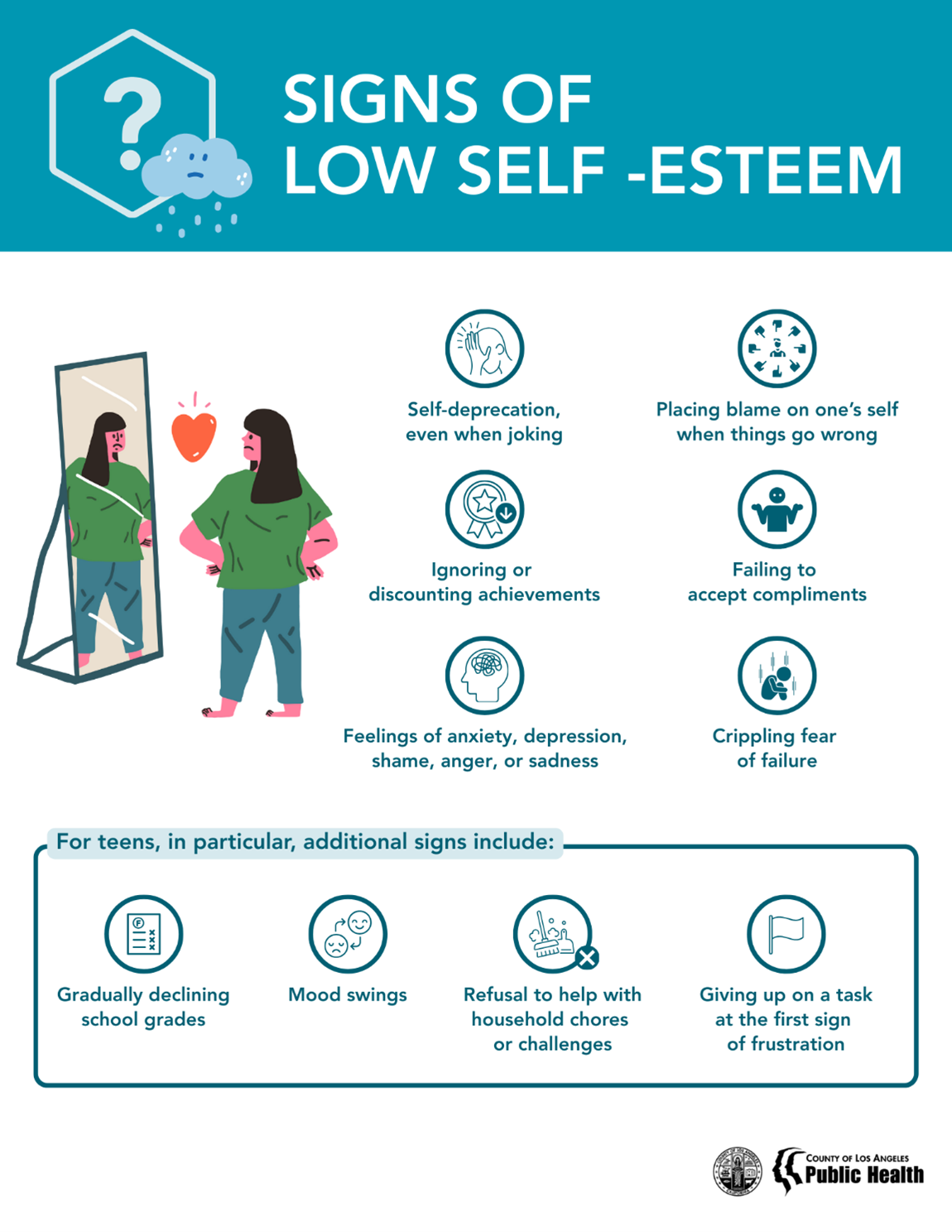
Tips for Supporting Self-Esteem
-
Be mindful of marketing tactics. Ask yourself:
- “Is this real?” – Most of the time, the image is posed, filtered an/or edited.
- “Is this image realistic?” – Genetics determine height, eye color, body shape and other characteristics. If an “ideal” image has to be achieved through drastic measures like restrictive dieting, expensive products, extreme workout plans or surgery, this image may not be a good fit for your genetic makeup. Trying to reach this image could be harmful to your physical and mental health.
-
Pay attention to your inner dialogue:
- Speak kindly to yourself.
-
Celebrate what makes you unique:
- Write down five or more qualities, that have nothing to do with your appearance, that you love about yourself. By focusing on these qualities, you can make a positive impact on the world and feel more confident about what make you uniquely one of a kind.
-
Consider your beauty ideal:
- Trends come and go. One year skinny is hot, the next curvy is in. Unless you’re a shape shifter, it’s unrealistic to always fit every standard of beauty. In fact, nothing about you needs to be “fixed”. Each person is unique and beautiful in their own way, you get to decide what that means to you regardless of what trends are in today and out tomorrow. Celebrate the qualities that make you unique, feel confident in your own skin and inspire others to also feel comfortable with themselves.
-
Clean your newsfeed:
- Unlike or unfollow accounts that trigger negative thoughts about your body or appearance.
-
Follow people who inspire you:
- Add and follow accounts, podcasts, newsletters or video channels that inspire you to make healthy choices and feel good about yourself.
- Use the time away from social media to invest in real life activities instead.
In Foster Care
Being in foster care can be difficult and feel lonely at times, but you are not alone.
- The Foster Youth Rights Handbook can help you learn about your rights and services available to you here in Los Angeles and across the state of California, for a more secure future.
-
Whether you need assistance with mental health services, school, employment, living independently, or looking for other resources, the Los Angeles County Department of Children and Family Services (DCFS) is a great starting point for you.
- Learn about health insurance, mental health, substance abuse, sexual and reproductive health and expectant youth services available to you by visiting DCFS’ Health and Mental Health page.
- The Department of Mental Health, DCFS and other community providers have come together to form the Multidisciplinary Assessment Team (MAT) to ensure the immediate and comprehensive assessment of children and youth entering out-of-home placement. Learn about the MAT program here.
- If you need immediate help, you can call the Family Urgent Response System (FURS), which includes a free 24/7/365 hotline for current of former foster youth (up to age 21) and caregivers to call and get immediate help and in-person support when needed for any issues, big or small. Call or text FURS at 1-833-939-3877.
With Special Healthcare Needs
If you are a person with a developmental disability, you can receive mental health care through a regional center.
- To be eligible for regional center services, you must have a substantial disability that began before your 18th birthday and is expected to continue indefinitely. Persons interested in regional center services must first obtain a diagnosis and assessment of their disability from a regional center.
- There are 7 Regional Centers in Los Angeles County. The Los Angeles County Department of Mental Health provides more information on their Regional Centers webpage.
- For more information about regional center services, supports and eligibility, visit the Department of Developmental Services – Regional Centers.
LGBTQIA+
When it comes to mental health support, it is important to connect with someone who understands your daily challenges. Los Angeles County is home to organizations that provide safe spaces, affirm who you are, help you love yourself, provide counseling and mental health services.
- Colors LGBTQ Youth Counseling Services provides free LGBTQIA+ affirmative counseling and healing psychotherapeutic services to youth under 25 and their families in greater Los Angeles.
- Kaleidoscope supports LGBTQIA+/Questioning neurodivergent and neurotypical youth, young adults and their families in building healthy relationships, strong social connections and critically needed life skills. They provide affirming mental health services, social support and life skills coaching to help each person realize their unique potential and thrive!
- Los Angeles LGBT Center is one of the largest and most experienced providers of LGBT health and mental healthcare, supported by a research team working to advance the care and treatment of lesbian, gay, bisexual, and transgender people. They accept Medi-Cal, Medicare, most major insurance plans, and some HMOs. If you are uninsured, we can help you get insurance through Covered California
- Penny Lane Center’s LGBTQ+ Programs are designed to help LGBTQ+ youth and their families find the support they need, while helping to create safe and welcoming spaces.
- Rainbow Pride Youth Alliance is for LGBTQ+ youth and allies in the Inland Empire. They provide a safe space for youth to meet, make friends and participate in their weekly events and activities. They offer support and resources for gender affirmation and community building. They also have a parent/caregiver program!
Males & Teens of Color
Mental health care is just as important as our annual physical. However, the stigmas related to mental health care services continue to affect and limit the access to services for those who identify as a male or male of color. The following are resources for you.
- Los Angeles County Department of Mental Health’s iPrevail Program provides 24/7 online support where LA students have an opportunity to chat with a peer coach to discuss personal challenges, enroll in a program, or interact in a virtual community to learn healthy habits, ways to manage stress, or lessen anxiety.
- Mental Health America of California provides mental health resources, support and services to live a full and productive life.
- My Brother’s Keeper (MBK) was launched by former President Obama in February 2014. The President called upon cities, counties, and tribal governments to make a commitment to improving outcomes for boys and young men of color. The MBK Challenge outlines six goal areas to increase education, employment, and safety.
- National Alliance on Mental Illness (NAMI) is the nation's largest grassroots mental health organization dedicated to educating, advocating, supporting, and building better lives for the millions of individuals & families affected by mental illness.
- TherapyForBlackMen.org provides proactive, multiculturally competent care to men of color through partnership with licensed mental health professionals and coaches in private practice.
Undocumented
Reasons for migration are varied and include moving away from persecution, human right abuses, disasters, war, reuniting with family, and seeking new opportunities. During the relocating process, you and your family may have experienced trauma, fear, and anxiety. We understand that language and immigration status add additional barriers that can make finding mental health services in the U.S. difficult. However, there are services available in Los Angeles County that provide health care to everyone regardless of immigration status.
- Los Angeles County Department of Health Services has a list of specialized services for immigrant populations at Immigrant Services website and 211LA is another helpful tool for Immigration Resources (211LA). El Centro De Amistad offers free mental health support to uninsured or undocumented individuals between the ages of 0 and 64.
